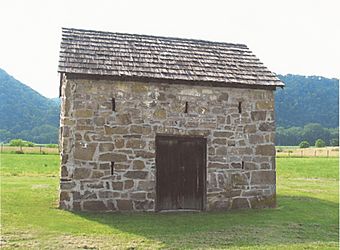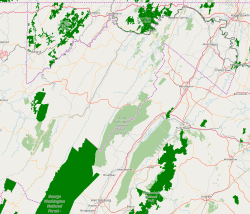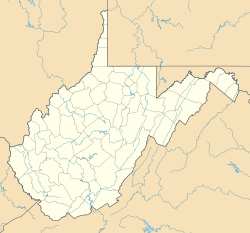Fort Van Meter (Hampshire County, West Virginia) facts for kids
Quick facts for kids |
|
|
Fort Van Meter
|
|
 |
|
| Location | South Branch River Road (County Route 8), Glebe, West Virginia |
|---|---|
| Area | 1.9 acres (0.77 ha) |
| Built | 1754 |
| Architectural style | side-gabled |
| NRHP reference No. | 09001191 |
| Added to NRHP | December 30, 2009 |
Fort Van Meter is an old stone fort from the 1700s. It is located in the South Branch Potomac River Valley in Hampshire County, West Virginia. This historic fort is about 9 miles southwest of Romney, West Virginia. It sits near a rugged river gorge called The Trough.
This small, rectangular stone building was built around 1754. Its main purpose was to protect early settlers from conflicts with some Native American tribes, like the Lenape and Shawnee. Fort Van Meter is still standing today. It has been recognized as an important historical site since 2009.
What Fort Van Meter Looks Like
Fort Van Meter is a small building made from local stone. The stones are not perfectly lined up, which gives it a unique look. It has a roof that slopes down on two sides, called a "pitched and side-gabled roof." The roof you see today, with its wooden beams and cedar shingles, was rebuilt in 1987.
The fort's floor inside is about 19.6 feet long and 13.8 feet wide. Its walls are quite thick, about 15 inches! These thick walls have special openings called "firing ports" or "loopholes." These small openings, about 6 to 12 inches high and 2 to 3 inches wide, allowed people inside to shoot muskets safely.
The History of Fort Van Meter
About ten years before Fort Van Meter was built, a family named Van Meter settled nearby. Isaac Van Meter, his wife Annetje Wynkoop, and their four children moved to an area called "Indian Old Fields" around 1744. This spot was about 8 miles upstream from where Fort Van Meter now stands. The Dutch-American family first built a strong log home there.
The land where Fort Van Meter was built was officially given to Henry Van Meter (likely Isaac's son) in 1749. This was done by Thomas, Lord Fairfax, an important land owner.
By 1754, the Van Meter family felt they needed an even stronger building. This was just two years before the French and Indian War officially began. So, they built the stone fort downstream, which became known as Fort Van Meter. It's a bit confusing because their first settlement, Fort Pleasant, was also sometimes called "Fort Van Meter." However, nothing remains of the original wooden fort at Fort Pleasant today.
Fort Van Meter was part of a long line of forts. These forts were built along the frontier of the Allegheny Mountains to protect settlers. Many forts were built especially after 1756. Fort Van Meter was smaller than some others. It was never used by Colonel George Washington's Virginia Regiment because it didn't have enough space for many soldiers.
However, unlike most other forts of that time, which were made of wood, Fort Van Meter was built from stone. This is why it has survived so well until today! It's thought that a skilled local builder named Nathaniel Kuykendall and his son Isaac might have built it.
In later, more peaceful times, the fort was used for storing and salting meat. The property changed hands over the years. It passed to Abraham Van Meter in 1804 but was sold out of the family in 1833. Fort Van Meter is one of five important Van Meter family homes that still exist. The others include Fort Pleasant, Traveler's Rest, Garrett VanMeter House, and Buena Vista Farms.




